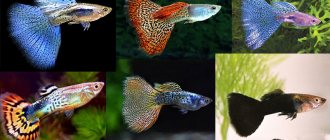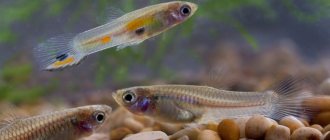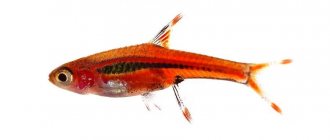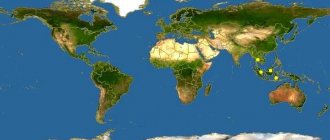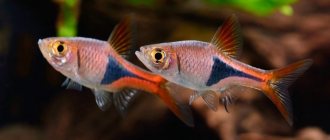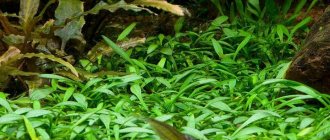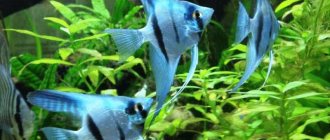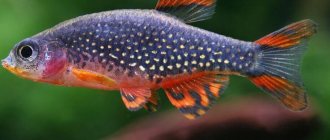Feeding
Analysis of the stomach contents of fish living in nature showed that they feed on various insects: worms, larvae, zooplankton.
In the aquarium they eat all types of food, but for more active behavior and bright colors, they need to be regularly given live or frozen food: bloodworms, brine shrimp, tubifex.
It’s just important to remember that the rasbor’s mouth is very small and the feed fractions should be small.
Diseases
Rasbora has a strong immune system, but due to violations of the conditions of detention, the fish can get sick:
- Digestive problems . An unbalanced, monotonous diet with a predominance of dry food can cause a similar problem. We need to reconsider the fish menu.
- Temperature shock . Due to the sharp temperature change, the fish experience serious difficulties with coordination and movement.
- Lack of oxygen and resulting hypoxia . Signs include fish being close to the surface of the water, poor coordination and lethargy. Keep the aerator clean and in good condition.
- Ammonia poisoning . Due to faulty filters and too infrequent water changes, the level of ammonia in the water rises sharply, which leads to poisoning and even death of fish. Regular soil cleaning and water changes will help avoid such troubles.
Rasbora wedge-spotted is a wonderful, cheerful fish that will enliven any aquarium with its energy.
Keeping in an aquarium
It is one of the most unpretentious and adapts to various conditions. To maintain a small aquarium, 40 liters is enough for a flock.
It is better to keep them in water with an acidity pH of 6-7.8 and an average hardness of up to 15°dH. However, it tolerates other parameters well. But for breeding you will have to try hard.
Filtration of water is desirable, but you can use not very powerful filters, as long as the water is clean. Be sure to change up to 25% of the water with fresh water weekly.
The aquarium in which you are going to put the fish should be densely planted, with open areas for swimming. They prefer species that occur naturally in habitats, such as Cryptocoryne or Aponogeton, but other species will do.
Dense thickets and snags will help rasboras find shade and relief from the stress of relocation.
It is also a good idea to let floating plants float to the surface of the water; in nature they live in reservoirs that are tightly covered by the crown of tropical trees.
It is important to keep fish in a school, since this is how they live in nature. The minimum quantity is from 7 pieces.
Description
The appearance of the fish cannot boast of bright colors : the scales of the rasbora are in calm grayish tones. But many aquarists treat these pets with great love.
Appearance
The rasbora's body is elongated, rather high and laterally flattened. The color of the fish is calm, in a gray-pink tones, with a dark, almost black wedge-shaped spot, which is located from the middle of the body to the anal fin (in males), and in females - slightly short of it.
By the shape of the spot you can distinguish gentlemen and ladies:
- in females the spot has rounded corners;
- in males, the corners of the spots are sharp and distinct.
Behavior
Rasboras are peaceful and mobile. These are schooling fish that will need a fairly long aquarium with plenty of hiding places, driftwood, algae and decorative elements so that the fish can play or hide.
Lifespan
Under good conditions, the fish can live in an aquarium for up to 4 years . Rasboras do not tolerate loneliness well - it can shorten their lifespan by half.
Compatibility
A very peaceful and easy-going aquarium fish, which is suitable for beginner aquarists.
It does not require any special conditions and gets along well with other types of tetras, such as neon, black neon, erythrozonus and pristella.
However, when choosing, you need to remember that the heteromorph rasbora is a very small fish and large and predatory fish will consider it as food. For example, you definitely shouldn’t keep her with kissing gouramis, piranhas and black pacu.
They need to be kept in a flock, in which they will be less stressed and more brightly colored. Males become especially brighter when surrounded by females.
Popular types with photos
Several varieties have been developed from rasbora material.
Rasbora heteromorph or wedge-shaped (Trigonostigma heteromorpha)
A representative of aquatic fauna that has long been known to aquarists, it is the most atypical rasbora among others. The fish is large (males can exceed the 4-centimeter mark by almost a quarter).
The fins have a pinkish tint; the dorsal fin of males is brighter than that of females. A distinctive feature is a black wedge-shaped spot.
Rasbora espei (Trigonostigma espei)
A more elegant and miniature variety of rasbora. It is distinguished by a brighter color than that of the heteromorph and a slightly concave spot at the bottom, the shape of which no longer closely resembles a wedge.
Hengeli's Rasbora (Trigonostigma hengeli)
The color is yellowish-gray, not too bright. This fish is often confused with the Espei rasbora, although they can be distinguished by the intensity of their color.
Rasbora somphongsi (Trigonostigma somphongsi)
The smallest representative of the species, its body length barely reaches 35 mm.
The body is elongated, low, the wedge looks more like a longitudinal strip than a spot. The color of the fish is golden-greenish.
Mr. Tail recommends: varieties
Natural subspecies of Rasbora are more popular than breeding ones. There are three groups of Harlequins in total:
- black - dark color, the spot is faintly visible;
- blue - sky-colored scales with a steel tint;
- golden - the belly is painted in the color of precious metal.
Range and Habitat
Cuneiform rasboras (Genus Trigonostigma) distribution areas.
This genus is widespread in water bodies of South and Southeast Asia, Indonesia and the Philippines.
Wedge-spotted rasboras (Genus Trigonostigma) habitats, biotope
Representatives of the genus are mainly schooling fish that stay in the upper layers of stagnant and slow-flowing reservoirs.
Adviсe
- When buying food for rasbor, carefully look at the expiration date. Do not purchase feed by weight.
- Place newly acquired fish in a quarantine aquarium for 3-4 weeks. During this time, possible diseases appear that could have been introduced into the general aquarium. If the fish show no signs of illness, place them in a community aquarium.
- Use peat filtration to acidify the water.
- A cover equipped with wires and a light bulb socket will create less hassle when installing the light.
- Choose a transparent siphon to make cleaning easier.
This species is confused with the Espes rasbora and Hengel's rasbora due to its similar appearance. The description of these species is largely identical: they come from the same conditions, have a similar character and live in schools. The fish are separated into a separate genus due to the fact that they glue their eggs to the leaves of plants, and do not scatter them in the water column.
Previous
FishTransparent glass catfish in an aquarium
Next
Fish Compatibility chart 44 aquarium fish
Motherland
Rasbora heteromorpha is found naturally in all large and small bodies of water in the south and east of Asia. Large concentrations of representatives of this fish are seen in rivers and streams flowing in dense jungles. And this is not surprising! Indeed, due to the location of numerous flora roots, the water becomes soft, acquiring high acidity. By the way, it is because of this that water in Asia is often dark in color (they are called “tea water”).
Historically, the heteromorph was found only in Asian countries. However, with increasing international economic ties, its habitat has expanded throughout the world. It was brought to Russia a year before the death of the legendary ship Titanic, in 1911 from Singapore.
Characteristic external data:
- small size;
- the body is high and compressed at the sides;
- thin tail;
- fins have two shades (pink on the chest and abdomen, red on the back and tail);
- green back;
- silver belly;
- a wedge-shaped black spot from the tail to half of the body (the sex of the individual of this marine representative is determined by its shape).
Like most fish, females are larger than males. They differ in the edges of the wedge - they have a blunter cut in females.
The behavior is quite active - the fish are constantly moving. However, the character itself is phlegmatic and calm.
They feed on worms, insect larvae, and zooplankton.
Rasbora Espei (Trigonostigma espei)
Rasbora Espei (T. espei) representative of the genus, appearance.
It differs from the previous species in its slightly smaller size, graceful build, copper-red overall color tone, thinner and elongated spot wedge with a concave lower edge, reminiscent of a knife blade (in English this fish is called 'lambchop rasbora'). Peaceful schooling fish for a community aquarium with shady areas. Dense vegetation as shelters: broad-leaved plants and soft, slightly acidic peat water. There are two isolated populations of this species: one in the southwestern part of Thailand, the other in the southeast of the country, on the border with Cambodia. Coloration can vary noticeably depending on the habitat. Length: does not exceed 3.5 cm. Water: temperature 23–28 C; pH slightly acidic below 7; soft, dN 2-10. Food: live, frozen and dry. Area: Thailand, Cambodia.
Genus Boraras – R. dwarf
The genus unites very small ones, no more than 2.5-3 cm long, with a short body, a long and narrow caudal peduncle and a characteristic pattern of their black spots and longitudinal stripes. Species from the islands of the Malay Archipelago differ from the mainland ones in their more elegant, thin profile. The coloration is dominated by various shades of red and in suitable conditions of a moderately shaded aquarium overgrown with plants, a flock of them literally sparkles with rich colors. Due to their small size and eye-catching colors, they are often called Hummingbirds . It is not surprising that these little ones have become increasingly popular in recent years, despite the fact that their maintenance usually requires a separate tank without larger, annoying neighbors. The Latin name is obtained by rearranging the letters in the word Rasbora.
R. Brigid
R. Brigitta (Boraras Brigittae)
The brightest and most attractively colored representative of the genus. This is one of two species of R. dwarf, bearing on the lateral surface of the body a longitudinal black stripe slightly expanding in front. R. Brigitte differs from the similar R.-firefly (B. Urophthalmoides) in its rich red or orange color, shorter, often intermittent stripe and the absence of a pronounced black spot at the base of the caudal fin. In nature, it is found only in the southwest of Kalimantan.
R. Spotted, Pygmy Hummingbird
R. Spotted (B. Maculatus)
The most famous of the group of R. Dwarf Spotted, in which, unlike the previous ones, the pattern is not stripes, but individual spots located in the middle part of the body and at the base of the anal and caudal fins. They are characterized by a large rounded dark spot on the side behind the gill cover and a uniform, rich orange-red coloring of the entire body. It is found in the very south of Thailand, on the Malay Peninsula, Sumatra and Kalimantan.
R. Measure
R. Merah
The species of R. dwarf spotted are very similar to each other and some skill is required to identify them. The differences mainly come down to the shape and size of the spots, as well as the general nature of the color. R. Mera is distinguished by a front spot and a rounded spot at the base of the anal fin, as well as a concentration of brightly colored zones around the spots and along the midline of the body, the remaining areas are paler. Endemic to southern Kalimantan.
R. Tiny
R. Tiny (B. Micros)
A poorly known species that rarely goes on sale because it is clearly inferior in color to its more colorful relatives. Very often in literature, not to mention on the Internet, the image of Boraras Merah is given under its name. Real B. Micros are much paler in color, in golden yellow tones, and their dark spots are much less pronounced or even absent, giving way to small specks. Found in the Mekong basin in the northeastern regions of Thailand.
R. Firefly
Rasbora firefly (B. Urophthalmoides)
Outwardly very similar to R. Brigitte and is often sold under the name of this more famous and popular one. The firefly can be distinguished by a longer black stripe on the side, starting immediately behind the operculum and gradually thinning towards the caudal peduncle, behind which there is a rounded dark spot at the base of the caudal fin, the absence of black markings on the unpaired fins and yellowish tones in color. Distributed only on the mainland, Thailand, Cambodia and Vietnam.
B. sp. South Thailand
R. Southern Thailand
Not yet described, known under the commercial name Southern Thailand, which indicates their origin: they are brought only from the southernmost regions of this country on the border with Malaysia. Very attractive, by the nature of the pattern they resemble Boraras Maculatus - R. Spotted. The main difference is the unevenness of color; in R. Southern Thailand, bright red tones are concentrated mainly in the rear half of the body, while the head remains almost colorless.
- Microrasbora (click to go to page)
Reviews
According to surveys of many users of social networks, zoological sites, online stores and just people on the street, the fish of the described species is especially popular. And this is not surprising! Users note among the advantages: beautiful shade, calm character, lack of specific aspects of care, unpretentiousness to the environment, affordable price. Can't find any cons. Although for some the small size is a disadvantage. However, these are just subjective preferences, overshadowed by good reviews from the majority.
Rasbora wedge-spotted is a universal, popular fish for aquariums, unpretentious to its environment, and gets along well with other marine representatives. It does not require special care. It will become an ideal character of the underwater world for a beginning amateur aquarist. And its cost is in the low price category.
Reproduction
Breeding heteromorphs is similar to breeding other small fish. Both males and females reach sexual maturity at a minimum of 9 months and a maximum of 1 year of life. It is easy to distinguish the gender. Males are brighter and females have a rounder belly. According to the wedge: in males it is thinner and sharper, in females it is spherical.
The basis for reproduction is soft water.
Before spawning, the pair should be seated in separate containers and fed more (up to 6-7 times a day) for 14 days. Prepare a spawning aquarium with a minimum volume of 30 liters. Plant cryptocorynes and other representatives of flora with wide leaves in it. The landing of a group of fish occurs in the dark. There should be 2 males and 4 females in the spawning housing. Spawning occurs early in the morning.
03:57
Rasbora cuneiformis, heteromorph, breeding, keeping, feeding. Wedge-shaped.
11:35
rasbora heteromorph. breeding step by step.
The process takes place in several stages:
- Mating dances of males. Stimulation for spawning.
- Turning the female belly up on a green leaf (up to 100 pieces).
- Attaching eggs to the plant.
- Fertilization of eggs by the male.
Duration - several hours. Afterwards the parents are removed from the container. After 1-1.5 days, numerous offspring appear. The fry begin to swim after 7 days. It is recommended to feed the younger generation with ciliates, artemia, and specialized dry food.

